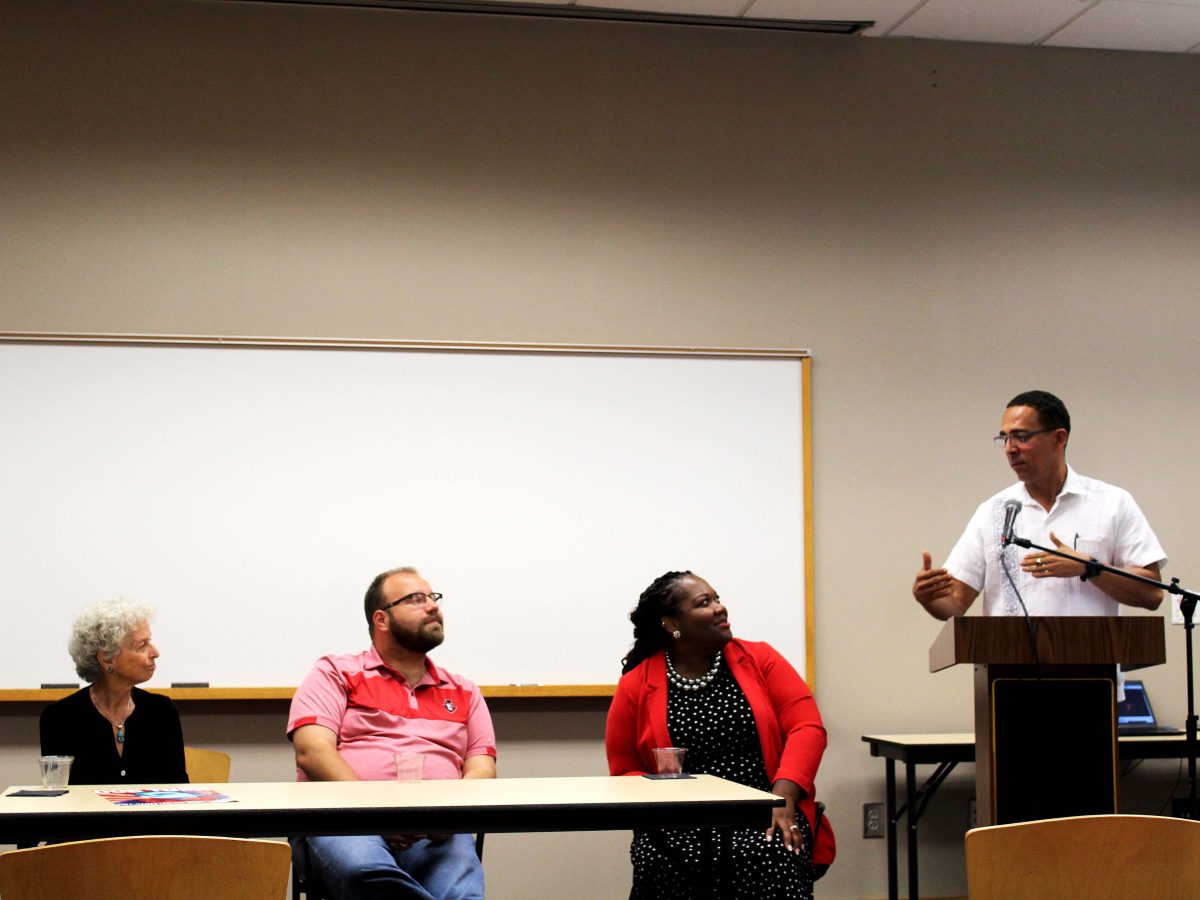The guest writer of this opinion piece is Kevin Baron, assistant professor of political science and public management at APSU. His research interests are the American presidency, congress, legislative development and the policy making process, political power, institutional reforms and the Freedom of Information Act.
The difficulty in assessing the violent insurrection at the US Capitol on January 6 that left at least five people dead is that there are so many factors that fed into the incident. The spectacle of violence is one that right-wing extremists have grounded their view of politics and society within. As historian Suzanne Schneider recently reminded us, “far-right movements fetishize violence as the premier form of civic participation.” The bigger question that remains unanswered is where do we go from here?
We can regard US history as defined by the continuous struggle of social movements, all seeking the same rights as granted to only a small group of citizens at the very beginning. The pro-democracy movement that began in the late-1820s paved the way for the enfranchisement of all white men by the mid-1850s. That same movement also brought about the Seneca Falls Convention and Declaration of Sentiments, proclaiming women as equal citizens worthy of the same rights and freedoms granted to men. Many in the women’s rights movement were closely aligned with the anti-slavery movement, working together with abolitionists to fulfill the promise of America in granting all the full rights and freedoms of citizenship. Of course, it would take a bloody civil war to end slavery and grant all men citizenship rights, though it was far from equal in practice. Women would continue their struggle for another 70 years after Seneca Falls until the passage of the 19th Amendment in 1920.
The forward progress made by these early social movements cannot be removed from the context that created the backlash to these movements. Following the Civil War, the calls for unity to move forward, rather than bother with accountability and face the difficult truths of what happened, were dominant. Lincoln’s assassination and the ascendance of Andrew Johnson to the presidency marked the beginning of the end of Reconstruction and Lincoln’s hope of rebuilding a multicultural democracy that sought to live up to the ideals the Framers espoused in the Declaration of Independence. In the name of healing and unity, the country quickly devolved into Jim Crow making segregation the law of the land. Violent right-wing extremists carried out lynchings and campaigns of terror to intimidate and control political power.
Equality and rights that had been granted on paper became meaningless in reality. New narratives developed to mythologize the South’s “righteous cause” and the rewriting of history became emblazoned through thousands of monuments and statues speaking of heritage instead of white supremacy, retelling the story to make the failed Confederacy both hero and victim. Rather than repudiate and hold accountable those who declared war against the United States in the name of white supremacy, by the early-20th Century monuments dotted the countryside extolling the “noble virtue” of Confederate leaders in their somehow ill-fated yet heroic cause against an overbearing federal government. Not just in the South, but across the country, the ideas of segregation rooted, continuing to feed racist ideas further.
Social movements continued, leading women suffragists to the right to vote but not the right to equal pay. Unionists fought and died for workers’ rights, including 40-hour workweek, overtime pay, benefits, and weekends. Black and brown Americans struggled under the yoke of segregation. The common bond between all, whether we are talking about race, gender identity or sexuality, or economic status, is that all of these social movements were met with violence. Throughout history, those seeking social change have often been met with violence from those holding onto the status quo. In the decades following World War II, as civil rights movements led to the end of legal segregation, the old divisions remained but were rebranded in a similar manner as they were following Reconstruction. Rather than many overt calls to racism, new narratives of “white victimhood” began, accompanied by labeling racial equality as
socialism and the redistribution of wealth to “undeserving others.” Dog whistle rhetoric replaced some overt racism, but the intent and meaning were still present.
The modern era has changed how we communicate, allowing for the quick dissemination of information, both fact and lies. Propaganda not only flows freely across social media and internet outlets but is broadcast into your home by the pundit class and cable news networks. These outlets have become proficient at profiting from what sells, and what sells is violence and spectacle. The violent backlash to social justice movements has been built upon an altar of alternative facts, an unreality in which many soak up their daily information. For decades Republican politicians have been making accusations and claims of voter fraud based on no evidence, yet the claims alone justified their political goals of passing laws to disenfranchise millions of voters. Hyperbolic and violent rhetoric from politicians influence the perspective of those who then carry out violent acts in real life.
Donald Trump lost his reelection to Joe Biden by more than 7 million votes and 74 Electoral votes. When Trump lost the Iowa Caucus to Ted Cruz in 2016, he claimed the election was rigged. When Trump lost the popular vote to Hillary Clinton, he claimed voter fraud. In the months leading to the 2020 election, Trump stated if he lost it was only because of voter fraud. But it was not just Trump. The Republican Party and many elected officials in Congress, including our own Senator Marsha Blackburn and Representative Mark Green, echoed the talking points of voter fraud, a stolen election, and that Joe Biden becoming president would mark the destruction of the country. For months, Republican leaders backed Trump and claimed voter fraud based on no evidence. They continued to claim the election was stolen after more than 60 lawsuits were thrown out due to lack of evidence, including two rejections from the Supreme Court. Both Blackburn and Green were part of the efforts in their respective chambers supporting the challenge to throw out Electoral votes, based on zero evidence. Mark Green has been claiming election irregularities and fraud for so long, that he now uses polling that shows voters believe the 2020 election was fraudulent as evidence to justify his throwing out millions of legally cast ballots. His circular and self-fulfilling logic is dizzying, and completely disingenuous.
As Trump and his congressional supporters whipped the crowd into a frenzy on January 6, using violent rhetoric and then sending them up to Capitol Hill, they may not have known what would happen, but they certainly knew what they were doing. They were lying. Trump has lied, Mark Green has lied, Marsha Blackburn has lied. Hundreds of White House, Republican Party officials, and congressional Republicans have lied to you. There is no other way to put it. They lied to protect their political power. They lied to subvert American democracy and the Constitution for their own political purposes. Once the states had certified the election results, once the Electoral College voted on December 14, and as no legal challenges could present any credible evidence to support claims of fraud, the election was over, and Trump lost. But that did not stop them from lying. The idea that somehow stopping Congress from certifying the Electoral votes on January 6 would change the election outcome was a total fantasy. However, right-wing social media and mainstream conservative media were peddling a different story, using Trump’s claims to build a false hope that the election outcome would miraculously change. Many of Trump’s supporters believed him.
The continued lies show how little Trump and his congressional sycophants care about their constituents because they are unwilling to be honest with the people they represent. As Senator Mitt Romney said in his speech following the insurrection at the Capitol, “The best way we can show respect for the voters who are upset is by telling them the truth. That is the burden, and the duty, of leadership.” Facts can be
a hard reality to face at times. Every election has a winner and loser, but in a healthy democracy, when your preferred candidates lose, you decide to work harder to mobilize voters for a different outcome the next time, not overthrow the government and Constitution by violent means because you’re angry.
But this is where America is in this moment – once again faced with the choice of being a multicultural democracy grounded in the ideals of the Framers that have yet to be achieved or continuing to be a society divided by a racial and economic hierarchy grounded in white supremacy and the politics of violence. To achieve the former, there must be accountability for the insurrection and the politics that influenced it. Impeaching Donald Trump a second time begins that process, the Senate holding him accountable by preventing him from holding office again would be better. But accountability must extend beyond Trump. He did not create the conditions that exploded earlier this month, he used and exploited them, just as many elected officials like Green and Blackburn have done for years. The hollow calls for unity from congressional Republicans in this moment are meaningless without accountability for their calls of division and their lies that have helped stoke the violence. As a nation and society, we are at a crossroads that will dictate the future. We can choose the former, face the difficult truths and work together to move forward, or we can choose the latter and move on without accountability. We have already seen where the latter choice brings us – the continued struggle of social movements seeking justice against the status quo power structure that will use violence to stop them.





